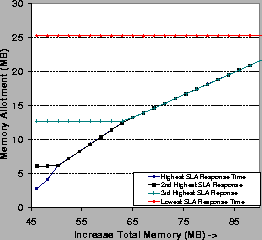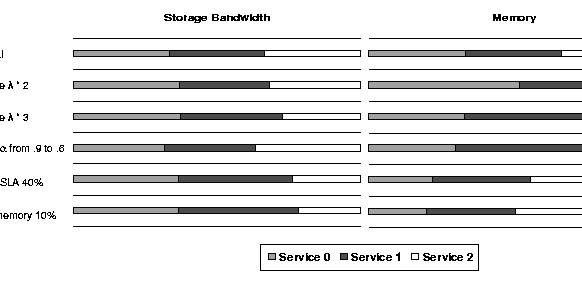 |

GroupAdjust adjusts a set of candidate allotment vectors to consume a specified amount of memory and/or storage resource. GroupAdjust may adapt the vectors to conform to resource constraints or to allocate a resource surplus to meet system-wide goals.
For example, GroupAdjust can reprovision available memory to maximize hit ratio across a group of hosted services. This is an effective way to allocate surplus memory to optimize global response time, to degrade service fairly when faced with a memory constraint, or to reduce storage loads in order to adapt to a storage constraint. Note that invoking GroupAdjust to adapt to constraints on specific shared storage units is an instance of storage-aware caching [16], achieved naturally as a side effect of model-based resource provisioning.
 |
GroupAdjust assigns available memory
to maximize hit ratio across a group as follows.
First, multiply Equation (1) for each
service by its expected request arrival rate ![]() .
This
gives
a weighted value of service hit rates (hits or bytes per unit
of time) for each service, as a function of its memory allotment M.
The derivative of this function gives
the marginal benefit for allocating a unit of memory to
each service at its current allotment M.
A closed form
solution is readily available, since Equation (1) was
obtained by integrating over the Zipf probability distribution
(see Section 3.1). GroupAdjust uses
a gradient-climbing approach (based on the Muse MSRP algorithm [12])
to assign each unit of memory to the service with the highest marginal
benefit at its current M. This algorithm is
efficient: it runs in time proportional to the product of
the number of candidate
vectors to adjust and the number of memory units to allocate.
.
This
gives
a weighted value of service hit rates (hits or bytes per unit
of time) for each service, as a function of its memory allotment M.
The derivative of this function gives
the marginal benefit for allocating a unit of memory to
each service at its current allotment M.
A closed form
solution is readily available, since Equation (1) was
obtained by integrating over the Zipf probability distribution
(see Section 3.1). GroupAdjust uses
a gradient-climbing approach (based on the Muse MSRP algorithm [12])
to assign each unit of memory to the service with the highest marginal
benefit at its current M. This algorithm is
efficient: it runs in time proportional to the product of
the number of candidate
vectors to adjust and the number of memory units to allocate.
 |
To illustrate, Figure 6 shows
the memory allotments of GroupAdjust to four competing
services with different cache behavior profiles
![]() ,
as available memory increases on the x-axis.
The left-hand graph varies the
,
as available memory increases on the x-axis.
The left-hand graph varies the ![]() and T parameters,
holding offered load
and T parameters,
holding offered load ![]() constant across all services.
Services with higher
constant across all services.
Services with higher ![]() concentrate more of their references
on the most popular objects, improving cache effectiveness for small
M, while services with lower T
can cache a larger share of their objects with a given M.
The graph shows that for
services with the same
concentrate more of their references
on the most popular objects, improving cache effectiveness for small
M, while services with lower T
can cache a larger share of their objects with a given M.
The graph shows that for
services with the same ![]() values, GroupAdjust
prefers to allocate memory to services with lower T.
In the low-memory cases, it prefers higher-locality services (higher
values, GroupAdjust
prefers to allocate memory to services with lower T.
In the low-memory cases, it prefers higher-locality services (higher ![]() );
as total memory increases and the most popular
objects of higher
);
as total memory increases and the most popular
objects of higher ![]() services fit in cache, the highest marginal
benefit for added memory
moves to lower
services fit in cache, the highest marginal
benefit for added memory
moves to lower ![]() services. These properties of Web service
cache behavior result in the crossover points for services with differing
services. These properties of Web service
cache behavior result in the crossover points for services with differing
![]() values.
values.
The right-hand graph in Figure 6 shows four services
with equal ![]() and T but varying offered load
and T but varying offered load ![]() .
Higher
.
Higher ![]() increases the marginal benefit of adding memory for a service,
because a larger share of requests go to that service's objects.
GroupAdjust effectively balances these competing demands.
When the goal is to maximize global hit ratio, as in this example,
a global perfect-LFU policy in the Web servers would ultimately
yield the same M shares devoted to each service.
Our model-based partitioning
scheme produces the same result as the reactive policy
(if the models are accurate), but it
also accommodates other system goals in a unified way.
For example, GroupAdjust can use the models to
optimize for global response time in a storage-aware fashion;
it determines the marginal benefit in response time
for each service as a function of its M, factoring in the reduced
load on shared storage.
Similarly, it can account for service priority by
optimizing for ``utility'' [12,21]
or ``yield'' [32],
composing the response time function for each service with
a yield function specifying the value for
each level of service quality.
increases the marginal benefit of adding memory for a service,
because a larger share of requests go to that service's objects.
GroupAdjust effectively balances these competing demands.
When the goal is to maximize global hit ratio, as in this example,
a global perfect-LFU policy in the Web servers would ultimately
yield the same M shares devoted to each service.
Our model-based partitioning
scheme produces the same result as the reactive policy
(if the models are accurate), but it
also accommodates other system goals in a unified way.
For example, GroupAdjust can use the models to
optimize for global response time in a storage-aware fashion;
it determines the marginal benefit in response time
for each service as a function of its M, factoring in the reduced
load on shared storage.
Similarly, it can account for service priority by
optimizing for ``utility'' [12,21]
or ``yield'' [32],
composing the response time function for each service with
a yield function specifying the value for
each level of service quality.